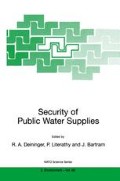Abstract
Water resources are subject to ever increasing risks of pollution. At the same time, more stringent quality requirements are being imposed on water destined for human consumption. To cope with this situation, water resources managers have set up early warning stations upstream of water treatment installations. Such warning stations are equipped with different sensors of a physical, chemical and biological nature.
Access this chapter
Tax calculation will be finalised at checkout
Purchases are for personal use only
Preview
Unable to display preview. Download preview PDF.
References
Fritz-Langen H., Blessing, B. and Krebs, F. (1992) Einsatz von Bakterientoximetern mit separater Zellanzucht zur kontinuierlichen Gewässerüberwachung, Biologische Testverfahren Beiträge zu den Biotest-Statusseminaren 1989 und 1992. Schr.-Reihe Verein WaBoLu 89, Gustav-Fischer Verlag, Stuttgart, 255–268.
Hoof (1994) Evaluation of a biomonitor based on the phototactic behavior of Daphnia magna using infrared biodection and digital image processing, Wat. Sci. Technology 30 (10), 79.
Knie, J. 1978, Der dynamische Daphnientest -ein automatischer Biomonitor zur Uberwaschung von Gewässern and Abwässern, Wasser Boden 12 301–312.
Kramer, K.J.M., Jenner, H.A. and de Zwart, D. (1989) The valve movement response of mussels: a tool in biological monitoring. Hydrobiologia 188/189 433–443.
Lesel, R. and Saboureau, J.L. (1976) Toxicité de substances à des doses sub-létales chez le poisson. I. Mise au point d’un testeur à courant d’eau circulaire, Centre Belge d ‘Etude et de Documentation des Eaux 389 140–144.
Morgan, W.S.G. and Kuhn, P.C. (1974) A method to monitor the effects of toxicants upon breathing rate of largemouth bass (Micropterus salmoides, Lacépède). Wat. Res. 8 67–77.
Ory, J.M., Jacques, F. and Boudey, Y. (1996), A biosensor for water quality monitoring IEEE Instrumentation and Measurement Technology Conference, Brussels, Belgium, June 4–6, 1996, 1–6.
Poels, C.L.M. (1975) Continuous automatic monitoring of surface water with fish Water Treatment and Examination 24 (1), 46–56.
Puzicha, H. (1994) Evaluation and avoidance of false alarm by controlling Rhine water with continuously working biotests. Wat. Sci. Tech. 29 (3),207–209.
Rigaud, G., Henriet, C., and Dowe, J. (1992) Une avancée décisive dans la détection automatique des pollutions: l’auto-microtox, Point Sciences Techn. 3 69.
Thomas, M. (1996) Biodétection en temps réel. Contribution à la réalisation d’un nouveau système de détection biologique de la pollution des eaux de surface, fondé sur l’exploitation des décharges auto-stimulatrices d’un poisson électrique tropical: Apteronotus albi cons (Apteronotidae - Gymnotiformes). Thèse de doctorat de l’Université Henri Poincaré, Nancy 1, 240 pages.
Thomas, M. (1997a) Etat de l’art sur les systèmes biologiques d’alarme précoce utilisés dans la surveillance des eaux brutes destinées à la production d’eau potable, 77` Congrès de l’AGHTM, Association Générale des Hygiénistes et Techniciens Municipaux, La Rochelle, 12–16 mai 1997,120–142.
Thomas, M. (1997b). Un nouveau système d’alerte précoce des pollutions des eaux: le Gymnotox, 77 e Congrès de 1 AGHTM, Association Générale des Hygiénistes et Techniciens Municipaux, La Rochelle, 12–16 mai 1997, 185–191.
Thomas, M., Florion, A., Chretien, D., and Terver, D. (1996) Real-time biomonitoring of water contamination by cyanide based on analysis of the continuous electrical signal emitted by a tropical fish, Apteronotus albirons. Water Research 30 (12), 3083–3091.
Author information
Authors and Affiliations
Editor information
Editors and Affiliations
Rights and permissions
Copyright information
© 2000 Springer Science+Business Media Dordrecht
About this chapter
Cite this chapter
Thomas, M. (2000). Integrating Physical, Chemical and Biological Monitoring. In: Deininger, R.A., Literathy, P., Bartram, J. (eds) Security of Public Water Supplies. NATO Science Series, vol 66. Springer, Dordrecht. https://doi.org/10.1007/978-94-011-4241-0_9
Download citation
DOI: https://doi.org/10.1007/978-94-011-4241-0_9
Publisher Name: Springer, Dordrecht
Print ISBN: 978-0-7923-6122-0
Online ISBN: 978-94-011-4241-0
eBook Packages: Springer Book Archive

